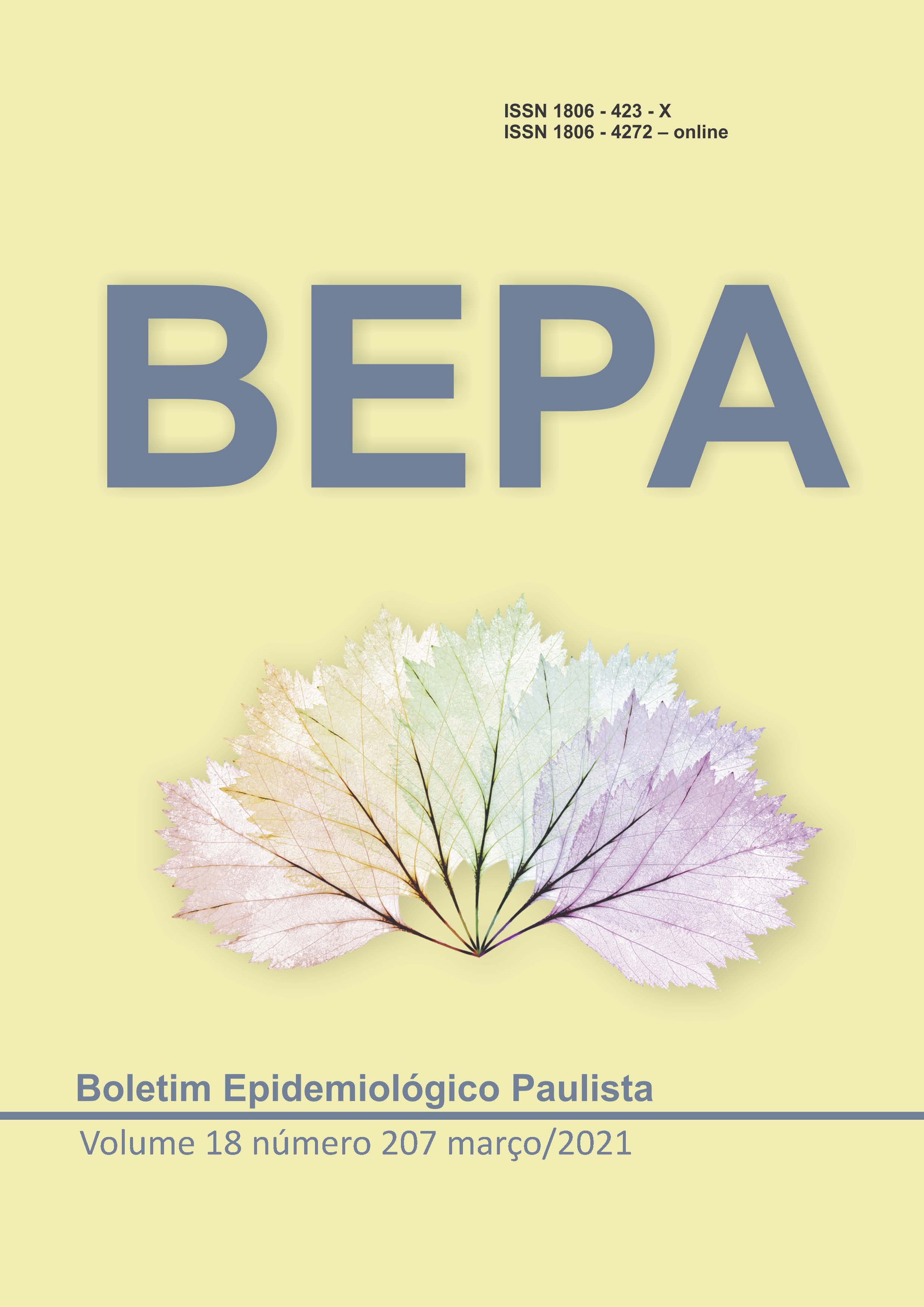Canine visceral leishmaniasis: Prevalence Ratio and spatial distribution of the risk for infection in the municipality of São Pedro, state of São Paulo, Brazil
DOI:
https://doi.org/10.57148/bepa.2021.v.18.35743Keywords:
Visceral Leishmaniasis, Dogs, Spatial analysis.Abstract
Visceral leishmaniasis (VL) is a vector-borne disease with a wide geographical distribution worldwide. In Brazil, this zoonotic disease has the dog (Canis familiaris) as its main reservoir. The aim of the study was to analyze the Prevalence Ratio for the canine visceral leishmaniasis (CVL) infection in areas with different amounts of dogs per property, and the spatial distribution of the risk - Relative Risk for infection for L.infantum by Censitary Sector in the city of São Pedro – SP, Brazil. Serological tests were carried out on 1,283 dogs, domiciled in 710 houses, and a dog was considered positive by the rapid immunochromatographic test, dual path platform - DPP® and the Enzime-Linked Immunosorbent Assay - ELISA. Prevalence Ratio was calculated by using the negative binominal regression type I, from the gamlss library and the Spatial Risk Ratio was obtained by Bayesian adjustment and spatial regression of the Censitary Sector in the same municipality. The results revealed that each additional dog per domicile could increase the Prevalence Ratio by 63%. There was a spatial risk increase in one of the Censitary Sector of up to 20% for L.infantum infection. We concluded that the current surveillance and control actions for visceral leishmaniasis should be prioritized and intensified within the Census Sectors identified as being of higher risk for infection by this study.
Downloads
Metrics
References
World Health Organization. Report on global surveillance of epidemic-prone Infectius diseases - leishmaniasis. 2014 [acesso em 12 mar 2020]. Disponível em: http://www.who.int/csr/resources/publications/CSR_ISR_2000_1leish/en/
Ministério da Saúde (BR). Secretaria de Vigilância em Saúde. Leishmaniose Visceral: o que é, causas, sintomas, tratamento, diagnóstico e prevenção. [acesso em 18 abr 2020]. Disponível em: http://antigo.saude.gov.br/saude-de-a-z/leishmaniose-visceral
Abrantes TR, Werneck GL, Almeida AS, Figueiredo FB. Fatores ambientais associados à ocorrência de leishmaniose visceral canina em uma área de recente introdução da doença no Estado do Rio de Janeiro, Brasil. Cad. Saúde Pública (online). 34(1): e00021117, 2018. doi: 10.1590/0102-311X00021117 [acesso em 17 abr 2020]. Disponível em: https://scielosp.org/pdf/csp/2018.v34n1/e00021117/pt
Azevedo AAA, Dias AKK, Paula HB, Perri SHV, Nunes CM. Avaliação daleishmaniose visceral canina em Poxoréo, Estado do Mato Groso, Brasil. Rev bras parasitol vet. 2008; 17(3):123-7
Borges BKA, Silva JA, Haddad JPA, Moreira EC, Magalhães DF, Ribeiro LMF et al. Presença de animais associada ao risco de transmissão da leishmaniose visceral em humanos em Belo Horizonte, Minas Gerais. Arq. bras. med. vet. zotec. 2009; 61(5): 1035-43.
Ursine RL, Dias JVL, Morais HA, Pires HHR. Human and canine visceral leishmaniasis in an emerging focus in Araçuaí, Minas Gerais: spatial distribution and socio-environmental factors. Mem Inst Oswaldo Cruz. 2016; 111(8): 505-11.
Chica AL, Perecin G, Holckman NM, Ciaravolo RM, Sampaio SMP, Holtz TM et al. Primeiras experiências da Vigilância Epidemiológica do município de São Pedro, Estado de São Paulo, frente a introdução da Leishmaniose Visceral Americana. In: Anais XXI Congresso do I Congresso Brasileiro de Parasitologia, II Encontro de Parasitologia do Mercosul. Novos Horizontes de Parasitologia. Foz do Iguaçu (PR). Revista de Patologia Tropical 38 (1) Suplemento (julho - setembro) 2009 CD.
Secretaria da Saúde (SP). Coordenadoria de Controle de Doenças. Superintendência de Controle de Endemias. Sistema de Informação Siszoo [internet] (Dados não publicados): Campinas: SUCEN; 2014.
Stasinopoulos DM, Rigby RA. Generalized additive models for location scale and shape (GAMLSS0) 2007; 23(7):1-46. doi:10.1111/j.1467-9876.2005. 00510.x
Camey SA, Torman VBL, Hirakata VN, Cortes RX, Vigo A. Bias of using odds ratio estimates in multinomial logistic regressions to estimate relative risk or prevalence ratio and alternatives. Cad. Saúde Pública. 2014; 30(1):21-9. doi http://dx.doi.org/10.1590/0102-311X00077313
Clayton D, Kaldor J. Empirical Bayes Estimates of Age-standardized Relative Risks for Use in Disease Mapping (1987). Biometrics, 43, 671-81
Albert Y. Kim and Jon Wakefield (2018). SpatialEpi: Methods and Data for Spatial
Epidemiology R package version1.2.3 [internet]; 2018. Disponível em https://CRAN.R-project.org/package=SpatialEpi
Silva SLC, Fachel JMG, Kato KK, Bassanesi SL. Visualização dos padrões de variação da taxa de mortalidade infantil no Rio Grande do Sul, Brasil: comparação entre as abordagens Bayesiana Empírica e Totalmente Bayesiana. Cad. Saúde Pública. 2011; 27(7):1423-32.
Marcondes M, Rossi CN. Leishmaniose no Brasil. Braz. J. Vet. Res. Anim. Sci. 2013; 50 (5):341-52.
Carvalho MR, Dias AFLR, Almeida ABPFA, Alves MR, Paes AS, Souza RF. Canine visceral leishmaniais: perception prevalence, and spatial distribution in municipality of Nossa Senhora do Livramento, Mato Grosso Brazil.. Braz J. Vet. Parsitol [internet]; 29(2): e 021019. [acesso em 26 fev 2021]. Disponível em: https://doi.org/10.1590/s1984/-29612020017 doi: 10.1590/S1984-29612020017
Rodrigues TF, Benitez NA, Sevá AP, Okamura LH, Galvão AB, Gomes JF et al. Spatial and seroepidemiology of canine visceral leishmaniasis in na endemic Southeast Brazilian area. Rev Soc Bras Med Trop (on line) 53: e 20190525, 2020. [acesso 26 fev 2021]. Disponível em: https://doi. org/10.1590/0037-8682-0525-2019.
Downloads
Published
How to Cite
Issue
Section
License
Copyright (c) 2021 Osias Rangel, Matheus de Melo Murbach

This work is licensed under a Creative Commons Attribution 4.0 International License.














